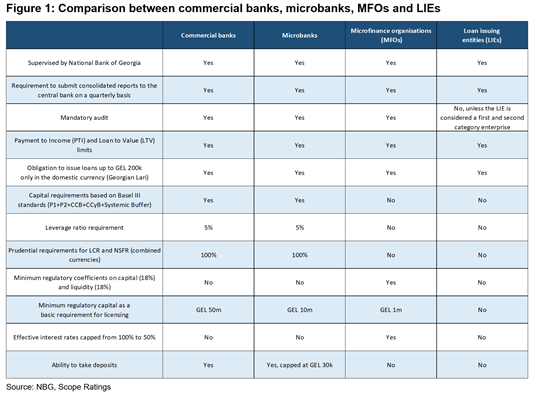Announcements
Drinks
Georgia: microbank law to enhance financial-sector competitiveness and support growth
By Alvaro Dominguez Alcalde, Financial Institutions
The granting of Georgia’s first microbank license to JSC MFO Business Capital (MBC) in December 2024 was an important milestone in the development of country’s financial sector. It also led to a rating upgrade for MBC to B+/Stable from B/Positive.
Microbanks will have a funding advantage over microfinance organisations (MFOs) and loan-issuing entities (LIEs) as they will be able to take deposits up to a maximum of GEL 30k (roughly EUR 10k) per customer, reducing their dependence on more expensive funding sources such as commercial banks, international financial institutions, and capital markets.
An important feature of the microbank framework that will support its growth is the tenfold increase in loan limits relative to MFOs: from GEL 100k for MFOs to GEL 1m for microbanks. At the same time, however, microbank status comes with stricter rules. For example, there is a mandatory 70% minimum of commercial and agricultural lending, although the National Bank of Georgia granted a two-year waiver for institutions that applied for microbank licences in 2023, lowering the minimum limit to 50%.
Scope expects a gradual transition of eligible MFOs that can meet the minimum capital requirements to microbanks, which implies that the residual MFO sector will focus mainly on consumer lending.
Georgia’s new microbanks are subject to more stringent regulatory requirements than MFOs, which should also reduce risks to creditors, potentially lowering funding costs over time. Microbanks have the same capital requirements as commercial banks, with a few exceptions such as an unhedged currency-induced credit risk buffer, a loan portfolio concentration risk buffer, and a net stress test buffer.
Microbanks are also subject to the same Net Stable Funding Ratio (NSFR) requirement, while there are minor differences in Liquidity Coverage Ratio (LCR) requirements. The minimum LCR requirement for microbanks is 100% for combined (foreign and local) currencies, and for foreign currencies, while the local currency requirement is 75%.

Microbank sector could reach GEL1bn by 2026
While the microbank sector is expected to be smaller than the MFO sector (which stood at GEL 2.3bn as of September 2024), we believe it is set to grow rapidly, as institutions can grant larger loan tickets. Assuming 20% annual growth in lending volumes, the sector could reach GEL 1bn by 2026.
Of the top 10 MFOs by total assets, accounting for over 90% of the sector’s total assets in 2023, only a few medium-sized organisations could apply for microbank licences without changing their portfolio breakdowns and thus their business models. However, the minimum capital requirement of GEL 10m will pose a considerable challenge for smaller candidates.
The National Bank of Georgia has a strict one-year deadline for making a final decision on granting microbank licences. However, even if an application is rejected, companies can re-apply without limitations. It is important to note that entities other than MFOs can apply for microbank licences.
See also:
- Scope upgrades JSC MFO Micro Business Capital’s issuer rating to B+, changes the Outlook to Stable, 10 December 2024
- Scope affirms the Republic of Georgia's BB credit ratings and revises the Outlooks to Negative, 11 January 2025
Issuer rating reports available in Scope Ratings:







